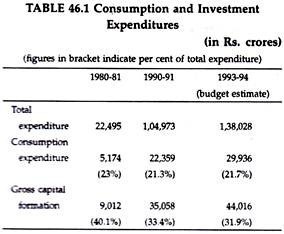In this article we will discuss about the Causes of Rise in Government Expenditure.
From the economic point of view, Government expenditure can be classified into consumption expenditure and investment expenditure. This is shown in the following table.
What is clear from this table is the growing importance of gross capital formation in absolute terms. In percentage terms, it is declining. Increase in consumption expenditure without a corresponding rise in revenue is bound to lead to a deficit budget which has an inherent inflationary potential.
ADVERTISEMENTS:
It is the nature or pattern of expenditure that explains the causes of rising of government expenditure. As time advances, not only developmental expenditure has been rising, but also non-developmental or non- plan expenditure has been rising steadily.
First, as the Government is playing an active role in the country’s development its developmental expenditure shows a rising trend. Immediately after achieving Independence, the Government initiated the planning process in order to achieve a faster rate of growth by making huge investments in different economic sectors as also on infrastructure. As public investment is rising as plans roll on, government expenditure is also rising.
Secondly, the major reason for the rising government expenditure throughout the world is the adoption of the welfare state principle. To maximise people’s welfare, the Government of India also spends a lot on various welfare activities.
ADVERTISEMENTS:
Thirdly, huge increase in defence expenditure— largely due to threats from neighbouring countries— is another reason. India has to maintain a large army and modernise its armed forces. Besides, cost of defence equipment is going up steadily over the years. Along with this, there has been a growing proliferation of subsidies resulting in a massive increase of non-developmental expenditure.
Fourthly, grants-in-aid to States have been increasing at a rapid rate.
Fifthly, extravaganza on the part of Government is considered to be another crucial reason. What is unfortunate is that even in the public sector no principle of economy is obeyed. There is no sign of austerity in various Government departments. In fact, the oil crisis in 1991 following the Gulf War forced the Government to economise this scarce resource.
For this, it issued notices to all departments and ministers. But nothing really happened.
ADVERTISEMENTS:
In fact, such order had been blatantly ignored. Again, wasteful and huge non-developmental expenditure is being incurred by the Government for providing undue facilities and perks to Ministers, MPs, MLAs, bureaucrats, etc. Furthermore, there are some consumption expenditures which are incurred by the Government as vote-catching devices.
Sixthly, the scale of Government expenditure has been rising to pay respect to parliamentary democracy. Elections, by-elections are conducted to establish parliamentary democracy, though, at times, election have turned out to be a ridiculous exercise. The year 1989 witnessed parliamentary election. The term for the Ninth Lok Saba was for five years.
But, a mid-term poll was conducted in May, 1991 for which an expenditure to the tune of Rs. 150 crores was incurred. The 1994-95 State Assembly elections would cost dearly since identity cards for voters had to be issued. For the entire country, the cost of identity cards would be roughly Rs. 1,700 crores. People are being asked to bear this huge cost by paying more of taxes.
Finally, chronic inflationary situation prevailing in the country is another cause of rising government expenditure.
Consequences:
Government expenditure has both desirable and undesirable effects. Coming to the favourable aspects, we can first say that huge government expenditure has not only diversified the Indian economy, but has also brought about a higher economic growth rate. By making investment in various sectors, the overall growth rate has been stepped up.
What is needed is that government concentrates more on increasing public investment expenditure which is indeed the main source of economic growth since it creates additional production capacity. Secondly, gross capital formation has risen over time due to various expenditures incurred by the Government. Thirdly, the social services sector has been widened incurring the public expenditure.
Coming to the other side of rising public expenditure, we observe that there is a great anxiety due to the growth debt-servicing burden. Debt-servicing refers to payment of interest along with a portion of the principal. This is non-developmental expenditure.
The interest on public debt is the price that the country has to pay for achieving faster growth. To meet its ever-growing expenditure, the Government borrows extensively not only from the market but also from abroad. The growth in internal and external debt and the increasing rate of interest have resulted in a mounting burden of interest payments.
ADVERTISEMENTS:
Between 1980-81 and 1992-93, internal debt as a per cent of GDP rose from 22.7% to 27.1% while external debt as a percent of GDP rose from 9.9% to 15.6%. Gross interest payments as a ratio of total expenditure almost doubled from 11.6% in 1980-81 to 20.5% in 1990-91.
Secondly, proliferation of public expenditure over the years has resulted in high rate of inflation. To meet its ever-increasing expenditure, the Government resorts to deficit budget. Chronic deficit budget has always fuelled the existing inflationary fire. Inflation begets inflation.
Thirdly, distortion in tax structure and heavy dependence on indirect taxes is the result of mounting government expenditure. To meet internal liabilities, the Government raises tax rate or imposes new type of taxes. With a high rate of taxes, tax evasion has become rampant.
Conclusion:
ADVERTISEMENTS:
The expenditure of the Central Government during the entire plan period was influenced by two major considerations:
(1) To protect the country from external forces and foreign aggression and
(2) To accelerate the pace of employment and the rate of growth of the economy by expanding its production capacity or branching out into new areas of economic activity.
Some observers have expressed the feeling that defence and development are contradictory objectives. They allege that India’s development effort has been considerably weakened due to the necessity of diverting scarce resources for meeting huge defence commitments.
